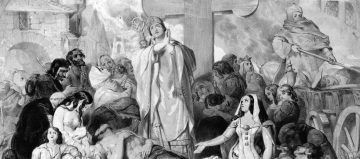Helen Carr in New Statesman:
 In the summer of 1348, a ship arrived in England, possibly sailing into the port of Southampton, carrying the most deadly cargo ever to reach the British Isles: Yersinia Pestis – bubonic plague. The highly infectious disease had erupted out of Asia, torn through Europe and finally found its way to England where it would devastate the infrastructure of the country, even wiping out entire towns such as Bristol. The symptoms of such a virulent infection were as dramatic as its spread. First a fever, cold and general flu-like symptoms, followed by blackening buboes forming in the joints – most commonly the groin or the armpits, creating its nickname, the Black Death. Sometimes people survived this stage but most commonly the infection would reach the bloodstream and death was inevitable – and usually swift.
In the summer of 1348, a ship arrived in England, possibly sailing into the port of Southampton, carrying the most deadly cargo ever to reach the British Isles: Yersinia Pestis – bubonic plague. The highly infectious disease had erupted out of Asia, torn through Europe and finally found its way to England where it would devastate the infrastructure of the country, even wiping out entire towns such as Bristol. The symptoms of such a virulent infection were as dramatic as its spread. First a fever, cold and general flu-like symptoms, followed by blackening buboes forming in the joints – most commonly the groin or the armpits, creating its nickname, the Black Death. Sometimes people survived this stage but most commonly the infection would reach the bloodstream and death was inevitable – and usually swift.
By November 1348 the disease had reached London, and by New Year’s Day 1349 around 200 bodies a day were being piled into mass graves outside the city. Henry Knighton, an Augustinian monk, witnessed the devastation of the Black Death in England: “There was a general mortality throughout the world… villages and hamlets became desolate and no homes were left in them, for all those who had dwelt in them were dead.” The panic, fear and hysteria surrounding the Black Death were unprecedented and, in a society driven by religion, the popular view was that the disease was a form of divine punishment. This consensus induced waves of ritual flagellation through the streets; people whipping themselves until bloodied, often not stopping even then. The finger of blame was also pointed at the Jewish community, leading to a period of brutal anti-Semitism. The mood was apocalyptic and “plague pits” were quickly dug in the suburbs of London – Smithfield being a favoured spot to bury the corpses of citizens of the City.
More here.
